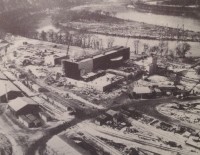Shippingport Reaches Criticality for the First Time
Which came first: the nuclear power plant or the nuclear-powered submarine? It sounds like a chicken-and-the-egg question, but the answer is quite simple: the nuclear-powered submarine.

Control Room, Shippingport Atomic Power Station. From Westinghouse Press Package in Will Davis library.
Now, I'm not about to get into the history of the U.S. Navy's nuclear fleet, which is its own amazing and unique story, but the first nuclear submarine, The USS Nautilus, and its history, do tie in significantly into the history of the first commercial nuclear power plant: Shippingport.
Admiral Rickover is a well-known name in both the nuclear community and the naval community. He spearheaded the creation of the world's first nuclear submarine, the USS Nautilus. The Nautilus was officially underway (i.e., doing its submarine thing in the water) on January 17, 1955.
Rickover, not known to sit around and be complacent, probably thought to himself, "You know, I wonder what else we can power with nuclear reactors..."
Turbines. The answer was turbines.
Because if you can take a tiny little reactor inside of a giant hunk of steel and send it hundreds of feet under the water to do all sorts of stealthy James Bond-gone-Navy missions, certainly you can size it up a few hundred percent and put it on a nice dry piece of land somewhere and turn a turbine with the same technology.
And that's just what happened. In 1953, President Eisenhower gave his famous "Atoms for Peace" speech, which emphasized the peaceful use of nuclear technology for things like commercial power generation. Shortly after, Rickover accepted a proposal from Duquesne Light Company (still around today, they powered my apartment in Pittsburgh) to build the first nuclear power plant.
(As a quick side note, you should know that Shippingport Atomic Power Station was built in Shippingport, Pa., about 25 miles northeast of Pittsburgh. While I was a student at the University of Pittsburgh, I always felt a little smug paying my electric bill, knowing that my money was directly supporting nuclear energy.)

Shippingport Atomic Power Station under construction. From Westinghouse Press Package in Will Davis library.
They broke ground for the nuclear power plant project in Shippingport in September of 1954. For three years the project continued. On December 2, 1957, history was made.
At 4:30 a.m., Shippingport Atomic Power Station went critical for the very first time.
This was a big deal. Can you imagine how Admiral Rickover and President Eisenhower felt knowing that their beliefs and efforts had come to fruition? Can you imagine how Duquesne Light felt, knowing that they held the market on the world's newest electricity source? (Profit. So much profit!)
What did happen is that Shippingport had a well-lived, 25-year life as a power plant before being fully decommissioned in 1988.
It's a shame I was not born to see Shippingport in action, although I have visited its nearby child- Beaver Valley. What I can hope for is that sometime in this lifetime we have another Shippingport moment. One where we successfully show the viability of a new technology which benefits humankind.
 Rita Patel is a double-graduate from the University of Pittsburgh with bachelor and master of science degrees in Materials Science Engineering, as well as a certificate in Nuclear Engineering. She has been an ANS National Member since 2011 and currently works in Washington DC. You can experience her witticisms first hand on Twitter via @RitaTherPita.
Rita Patel is a double-graduate from the University of Pittsburgh with bachelor and master of science degrees in Materials Science Engineering, as well as a certificate in Nuclear Engineering. She has been an ANS National Member since 2011 and currently works in Washington DC. You can experience her witticisms first hand on Twitter via @RitaTherPita.

